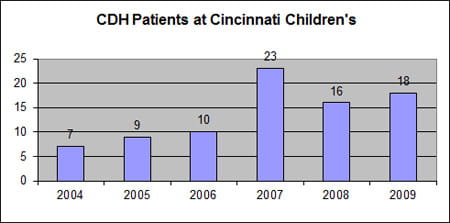Newborn with Left CDH and DORV: Team Collaboration Key to Successful Treatment
Clinical History and Presentation
Following a routine fetal ultrasound during pregnancy, a mother in the southeastern United States learned that her unborn baby boy was diagnosed with left congenital diaphragmatic CDH) and double outlet right ventricle (DORV). The mother was referred to the Cincinnati Fetal Center, located at Cincinnati Children’s Hospital Medical Center.
At 35 weeks, the newborn was delivered via Cesarean section at University Hospital. He was intubated in the delivery room and placed on mechanical ventilation for transport to the Level III-C Neonatal Intensive Care Unit (NICU) at Cincinnati Children’s.
Treatment Approach and Results
The newborn was placed under the care of a comprehensive medical team specializing in CDH care. The CDH Team includes neonatologists, pediatric fetal care surgeons, cardiologists, nurse practitioners, neonatal and surgical fellows, pharmacists and dietitians.
His CDH was successfully repaired three weeks after birth. The CDH Team cared for the newborn during the 72 days he was in the NICU, providing physicians from his home hospital with regular updates. The team conducted daily rounds to address the infant’s related anomalies (described below).
Respiratory Issues
Treatment
Upon admission, neonatologists continued his mechanical ventilation using a “gentle” ventilation or gentilation strategy; this helps avoid future chronic lung disease by using lower ventilation settings while accepting slightly abnormal pH and pCO2 levels.
Results
The first attempt at extubation on day 35 (two weeks after repair of his CDH) failed, but he was successfully extubated to high flow nasal cannula at 37 days. At 46 days, he began aldactone and diuril treatment; 10 days later, he was weaned off of high-flow nasal cannula to room air and remained stable. He was discharged with a pulse oximeter for home blood-oxygen monitoring.
DORV
Treatment
Due to the prenatal diagnosis of congenital heart disease, our cardiologist started him on prostaglandins upon admission. An echocardiogram showed a DORV with a large subaortic ventricular septal defect and a complex right ventricular outflow tract obstruction; moderate patent foramen ovale with bidirectional shunting and no patent ductus arteriosus; and fair left ventricular function. Because the infant had stable cardiac function with a closed ductus arteriosus on echocardiogram, prostaglandin treatment was discontinued.
Results
The infant’s heart repair was successfully completed in his home state.
Pulmonary Hypertension
Treatment
Immediately following admission, the team of neonatologists and pediatric surgeons initiated nitric oxide treatment for suspected pulmonary hypertension. It was difficult to accurately assess the degree of hypertension due to the infant’s cardiac defect. His pressures were initially estimated to be near systemic, but as desaturation episodes became more frequent and the infant’s oxygen requirement increased, the CDH Team decided his pulmonary hypertension was higher than revealed on echocardiogram and initiated Flolan treatment at nine days.
Results
At 25 days, the infant’s clinical condition had improved, so Flolan was discontinued. An echocardiogram at day 30 (nine days after repair of his diaphragm) estimated his pulmonary pressures to be 50 percent systemic. At that time, his nitric oxide was weaned; it was discontinued at 33 days. A follow-up echocardiogram at day 33 indicated slightly higher than 50 percent systemic pulmonary artery pressure. Our cardiologist recommended that he not be started on sildenafil. The most recent echo (day 71) showed pulmonary stenosis with a gradient of approximately 36 mm Hg, indicating slightly higher than 50 percent systemic pulmonary artery pressure. There was a large patent foramen ovale/atrial septal defect with left to right shunting.
Wolff-Parkinson-White Syndrome
Treatment
At 43 days, the infant began having episodes of supraventricular tachycardia; his heart rate rose to 240–260 bpm. Initially these episodes were asymptomatic, lasting only a few minutes each, requiring no pharmacologic intervention; he began to become diaphoretic with the episodes. At 47 days, the infant was diagnosed with Wolff-Parkinson-White Syndrome on electrocardiogram and propranolol treatment was initiated.
Results
The infant had no further episodes on propranolol. He is currently under the care of a cardiologist in his home state and has weaned off of propranolol.
FEN Management, Growth and Development
Treatment
Upon admission, the infant was started on TPN/IL. At 29 days he started with continuous nasojejunal (NJ) feeds, which were slowly increased. At 37 days, he began having apneic episodes and liquid stools. A septic workup was initiated, and the infant was kept NPO. The septic workup was negative; three days later his NJ feedings resumed and were slowly increased to maximize growth and weight gain. Once effective nutrition was established with NJ feeds, he was transitioned to continuous gastric feeds. Bolus gastric feeds were initiated on day 57. In addition, occupational and speech therapists provided ongoing therapy during his hospitalization to help ensure the development of proper oral feeding habits.
Results
The infant successfully tolerated his feeding advances and transition from NJ to gastric feeds. Upon discharge, he was placed under the care of a developmental progress specialist in his home state.
Follow Up
The NG tube was removed at four months of age; since then, he has grown well on full oral feeds. At 32 months of age, fine motor, social and self help skills were equivalent to 24-30 months; gross motor skills were equivalent to 20-24 months.
Discussion
Newborns with CDH, especially those with other complexities, present significant challenges in treatment and require a comprehensive medical team for good outcomes. In this case, the combination of the CDH with the DORV and pulmonary hypertension required a delicate balancing act using Flolan and inhaled nitric oxide to eliminate the hypertension and normalize the blood flow prior to repairing the CDH. In addition, combining unique treatments — delayed CDH repair, the use of Flolan, gentilation, and aggressive nutrition and feeding support to improve post-intubation feeding skills — have proven beneficial for our patients.




